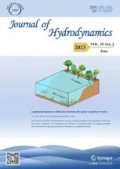Abstract
This paper applies the meshfree Smoothed Particle Hydrodynamics (SPH) method with Graphical Processing Unit (GPU) parallel computing technique to investigate the highly complex 3-D dam-break flow in urban areas including underground spaces. Taking the advantage of GPUs parallel computing techniques, simulations involving more than 107 particles can be achieved. We use a virtual geometric plane boundary to handle the outermost solid wall in order to save considerable video card memory for the GPU computing. To evaluate the accuracy of the new GPU-based SPH model, qualitative and quantitative comparison to a real flooding experiment is performed and the results of a numerical model based on Shallow Water Equations (SWEs) is given with good accuracy. With the new GPU-based SPH model, the effects of the building layouts and underground spaces on the propagation of dambreak flood through an intricate city layout are examined.
Similar content being viewed by others
References
TODA K., KURIYAMA K. and OYAGI R. et al. Inundation analysis of complicated underground space[J]. Joumal of Hydroscience and Hydraulic Engineering., JSCE., 2004, 22(2): 47–58.
TODA K., KAWAIKE N. and YONEYAMA S. et al. Underground inundation analysis by integrated urban flood model[C]. Proceedings of 16th IAHR-APD Congress and 3rd Symposium of IAHR-ISHS. Nanjing, China, 2009, 166–171.
HAN K. Y., KIM G. and LEE C. H. et al. Modeling of flood inundation in urban areas including underground space[C]. The 4th International Symposium on Flood Defense. Toronto, Ontario, Canada, 2008.
SOARES-FRAZÃO S., ZECH Y. Dam-break flow through an idealised city[J]. Journal of Hydraulic Research, 2008, 46(5): 648–658.
ABDERREZZAK K. El K., PAQUIER A. and MIGNOT E. Modelling flash flood propagation in urban areas using a two-dimensional numerical model[J]. Natural Hazards., 2009, 50(3): 433–460.
SCHUBERT JOCHEN E., SANDERS BRETT F. Building treatments for urban flood inundation models and implications for predictive skill and modeling efficiency[J]. Advances in Water Resources., 2012, 41: 49–64.
LAI Wencong, Khan Abdul A. Modeling dam-break flood over natural rivers using discontinuous Galerkin method[J]. Journal of Hydrodynamics., 2012, 24(4): 467–478.
LIU M. B., LIU G. R. smoothed particle hydrodynamics (SPH): An overview and recent developments[J]. Archives Computation Methods Engineering., 2010, 17(1): 25–76.
LO E. Y. M., SHAO S. Simulation of near-shore solitary wave mechanics by an incompressible SPH method[ J]. Applied Ocean Research., 2002, 24(5): 275–286.
DALRYMPLE R. A., ROGERS B. D. Numerical modeling of water waves with the SPH method[J]. Coastal Engineering., 2006, 53(2–3): 141–147.
MONAGHAN J. J. Smoothed particle hydrodynamics and its diverse applications[J]. Annual Review of Fluid Mechanics., 2012, 44: 323–346.
HÉRAULT A., VICARI A. and DELNEGRO C. et al. Modeling water waves in the surf zone with GPUSP-Hysies[C]. Proceedings of 4th SPHERIC International Workshop. Nantes, France, 2009, 77–84.
HÉRAULT A., BILOTTA G. and DALRYMPLE R. A. SPH on GPU with CUDA[J]. Journal of Hydraulic Research., 2010, 48(Suppl. 1): 74–79.
DALRYMPLE R. A., HÉRAULT A. and BILOTTA G. et al. GPU-accelerated SPH model for water waves and free surface flows[C]. Proceedings of 32nd International Conference Coastal Engineering. Shanghai, China, 2010.
JALALI FARAHANI R., DALRYMPLE R. A. and HÉRAULT A. et al. Turbulent coherent structures under breaking waves[C]. Proceedings of 7th SPHERIC Internatinal Workshop. Prato, Italy, 2012, 171–178.
HÉRAULT A., BILOTTA G. and VICARI A. et al. Numerical simulation of lava flow using a GPU SPH model[J]. Annals of Geophysics., 2011, 54(5): 600–620.
GOMEZ-GESTEIRA M., ROGERS B. D. and DALRYMPLE R. A. et al. State-of-the-art of classical SPH for free-surface flows[J]. Journal of Hydraulic Research., 2010, 48(Suppl. 1): 6–27.
SOARES-FRAZÃO S., ZECH Y. Experimental study of dam-break flow against an isolated obstacle[J]. Journal of Hydraulic Research., 2007, 45(Suppl. 1): 27–36.
Author information
Authors and Affiliations
Corresponding author
Additional information
Project supported by the National Basic Research Development Program of China (973 Program, No. 2012CB719705), the National Natural Science Foundation of China (Grant Nos. 91024032, 70833003).
Biography: WU Jian-song (1985-), Male, Ph. D., Lecturer
Rights and permissions
About this article
Cite this article
Wu, Js., Zhang, H., Yang, R. et al. Numerical modeling of dam-break flood through intricate city layouts including underground spaces using GPU-based SPH method. J Hydrodyn 25, 818–828 (2013). https://doi.org/10.1016/S1001-6058(13)60429-1
Received:
Revised:
Published:
Issue Date:
DOI: https://doi.org/10.1016/S1001-6058(13)60429-1




